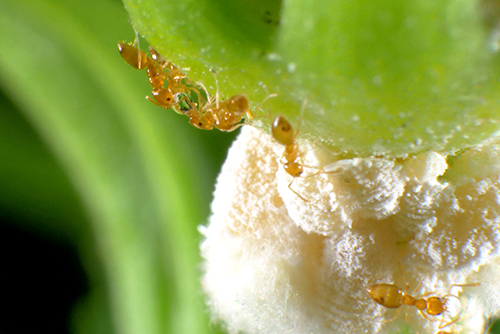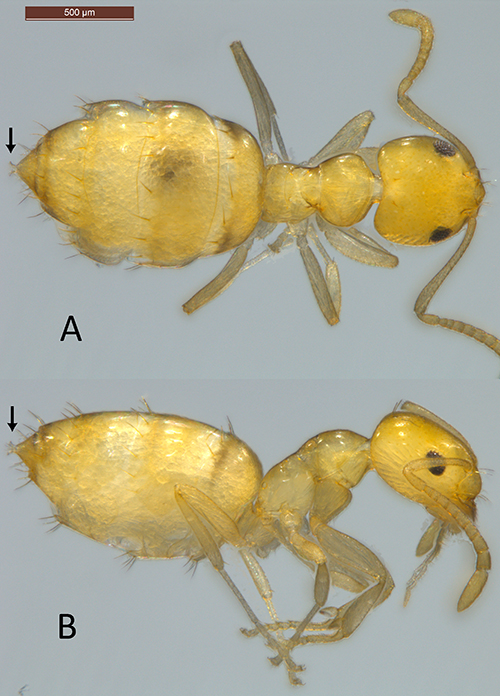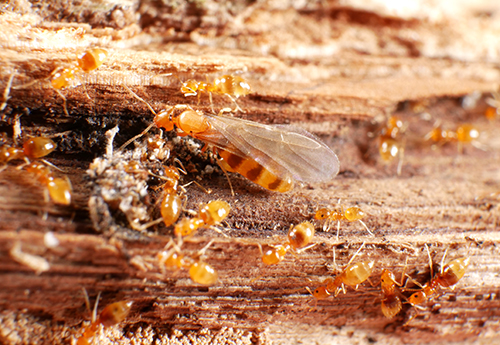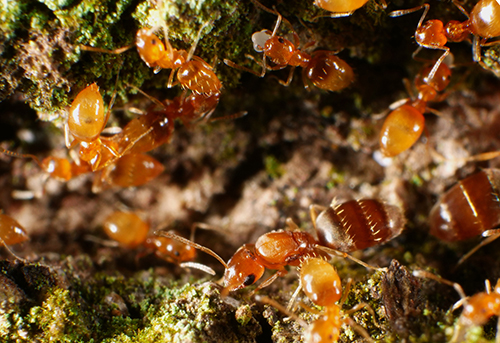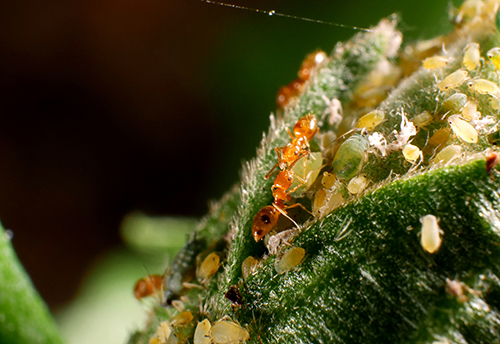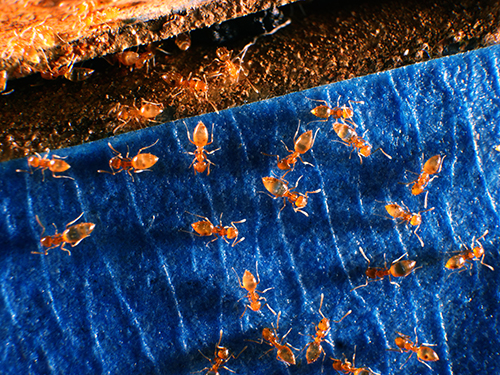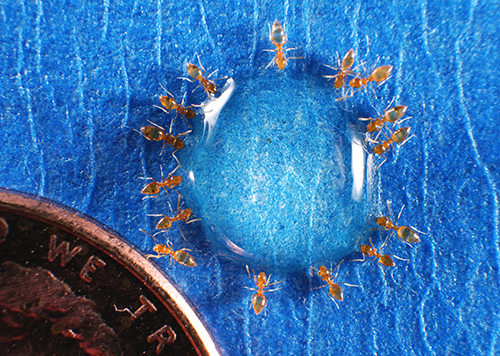common name: Alluaud’s little yellow ant
scientific name: Plagiolepis alluaudi, Emery (Insecta: Hymenoptera: Formicidae)
Introduction - Identification - Distribution - Synonymy- Biology and Life Cycle - Pest Status - Management - Selected References
Introduction (Back to Top)
Alluaud’s little yellow ant, Plagiolepis alluaudi Emery, 1894 (Figure 1), is a species of a very small, yellow ant thought to have originated from Madagascar and islands in the surrounding area of the Afrotropics of the Indian Ocean. It has become established as an invasive species in countries throughout the global tropics, and also in greenhouses in temperate climates (Wetterer 2014, Hernández-Teixidor et al. 2020). This species has long been established on islands across the Caribbean but, outside of a single non-recurring record in California, was first detected as established in the USA in 2017, in Florida (Broward Co.) (Chouvenc et al. 2018). This species can reproduce rapidly and reach high densities locally, making it a nuisance to homeowners, gardeners, and farmers. Because these ants actively tend to hemipteran sap-sucking insects, their presence can indirectly be detrimental to plants. Alluaud’s little yellow ant has the potential to spread in South Florida over time, and to be unintentionally transported beyond the state of Florida through horticultural trade through infested plant material.
Figure 1: Plagiolepis alluaudi Emery foraging on a Hibiscus sp. plant infested with mealybugs. Ants often collect honeydew produced by sap-feeding insects. Photograph by T. Chouvenc, University of Florida.
Identification (Back to Top)
Workers of Alluaud’s little yellow ant are small, approximately 1.5 mm in length, and vary in color from pale yellow to light orange. Individuals of this species do not possess a stinger, but rather, as in other formicine ants, have a nozzle-like, fringed opening at the tip of the abdomen (acidopore) where defensive secretions and pheromones, such as formic acid, are released (Figure 2). The head is nearly round in full-face view, and cardioform (heart shaped) in dorsal view (posterior margin incised). The cuticle on the head and body may be matte or smooth but lacks surface sculpturing. The antennae have 11 articles (segments) and only a single waist segment (petiole) is present, never a second (post-petiole).
These characters in combination distinguish Alluaud’s little yellow ant from two other similar species in Florida. Workers of Wasmannia auropunctata (Roger) (the little fire ant, https://edis.ifas.ufl.edu/publication/IN296), are of similar size, but much darker in hue (dark orange) and have a heavily textured head capsule as well as two waist segments (petiole and post-petiole). Brachymyrmex minutus Forel (the hairy yellow rover ant, https://www.antwiki.org/wiki/Brachymyrmex_minutus), also has minute, yellow workers with a fringed acidopore at the tip of the abdomen. The 9-segmented antennae and presence of very long setae, especially on the gaster distinguish Brachymyrmex minutus from Plagiolepis alluaudi.
Figure 2: Plagiolepis alluaudi Emery worker. A: dorsal view, B: lateral view. Arrows indicate the acidopore. Modified from Chouvenc et al. (2018).
Distribution (Back to Top)
Alluaud’s little yellow ant is established as a non-native species across the tropics in many Pacific islands, the West Indies, and countries in equatorial Africa. It is also found in horticultural greenhouses in Europe (Wetterer 2014). Its known distribution in Florida, which is limited to two localities in Broward County, suggests a relatively recent introduction event. As of 2021, Plagiolepis alluaudi has only been detected in two neighborhoods, Riverside and Riverland residential areas of Ft. Lauderdale. To date, surveys in the county have not detected additional populations (Miller 2020).
Synonomy (Back to Top)
The following names are listed as junior synonyms of Plagiolepis alluaudi Emery 1894 (Smith 1958, Wetterer 2014):
Plagiolepis mactavishi, Wheeler, 1908
Plagiolepis foreli, Santschi, 1920
Plagiolepis foreli var. ornata, Santschi, 1920
Plagiolepis augusti, Emery, 1921
Plagiolepis foreli, Mann, 1921
Biology and Life Cycle (Back to Top)
Life Cycle. The basic biology of this ant species is poorly described and much remains to be determined about its behavior, genetics, and physiology relevant to invasive success and, therefore, its potential for range expansion as an invasive species. The lifecycle can be expected to generally follow that of other formicine ants: individuals develop through the four holometabolous life stages of egg, larva, pupa, and adult. Workers in the nest tend to eggs and feed larvae. When colonies reach maturity, winged reproductive females and males (alates) are produced.
Reproductive biology. Plagiolepis alluaudi colonies contain many queens, a trait thought to contribute to their invasive success in various parts of the world by supporting rapid colony growth. However, it is unknown if all queens in colonies are reproductive, whether queens are produced through sexual reproduction or parthenogenesis, if colonies expand through budding or are formed independently and fuse only when established in close proximity, or whether alates disperse or remain in the nest. In Florida, alates (Figure 3) of both sexes can be found in nest material in late spring, from April through June. Flight phenology, if mating flights even occur, is unknown; it is possible that mating occurs inside the nest (Miller 2020).
Nesting. Plagiolepis alluaudi populations can form large, multi-nest colonies with many queens. Established populations were estimated to contain millions of workers and potentially hundreds of reproductive queens (Miller 2020). Interconnected nesting structures used by subsets of a few hundred to several thousand ants can be found in dried curled leaves, soft twigs, or partially decomposed branches or woody material. Large groups of Plagiolepis alluaudi can also be found in the soil material of potted plants. Nests may be in sturdy structures such as standing trunks or fallen logs, or they can be temporary, as colonies move, split, and relocate often (Figure 4), depending on weather, food availability and competition with other co-occurring ant species.
Figure 3: Developing (not fully sclerotized) female alate of Plagiolepis alluaudi Emery from a nest within a small dead branch on the ground. Photograph by T. Chouvenc, University of Florida.
Figure 4: Part of a Plagiolepis alluaudi Emery colony in the process of relocating. Note multiple queens (large bodied and darker than smaller workers) and brood (in mandibles of worker at top, center of photograph). Here, the colony moves in the open, on the surface of a tree trunk. Photograph by T. Chouvenc, University of Florida.
Foraging and feeding habits. Individual foraging workers scout the environment surrounding the nest for food resources. Plagiolepis alluaudi primarily feed on thin, sweet liquids but they have also been observed feeding on dead insects. Foragers feed on nectar, spoiled fruits, and, when present, extensively tend sap-feeding insects to collect their honeydew (Figure 5). These resources are brought back to the nest and shared with nestmates. Workers can be found on the soil surface, in leaf litter, and on various parts of plants, including foliage, stems, flowers, and fruits. They are able to forage high in tree canopies. Once a food source is located, heavy recruitment of several hundred to thousands of ants takes place and dense trails of ants can be traced from the nest to the resource (Miller 2020).
Figure 5: Plagiolepis alluaudi Emery foragers tending to aphids and feeding on their honeydew. Photograph by T. Chouvenc, University of Florida.
Pest Status (Back to Top)
Because of their outdoor nesting and feeding habits, Allauad’s little yellow ant seldom becomes an indoor pest. However, when populations grow extremely large, large trails of foragers can find their way into places with abundant moisture and/or food resources, such as kitchens and bathrooms (Figure 6). In such cases, they can become a recurrent nuisance.
The symbiotic interaction of this species with hemipteran sap-feeding insects (e.g., mealybugs, scales, and aphids) can result in large increases in the populations of sap-feeding insects on plants, potentially leading to poor plant health (Miller 2020). Therefore, in addition to being a potential household nuisance, they can also indirectly augment the pest pressure of detrimental sap-feeders in landscapes and in horticultural settings. Plagiolepis alluaudi ants do not sting, and the mandibles are so small that bite attempts are often not noticeable. However, a person under a tree harboring an established population of Plagiolepis alluaudi may notice a rain of workers regularly falling from the tree. These fallen individuals attempt to bite when trapped under clothing or in hair and can be quite irritating.
Figure 6: Infestation of Plagiolepis alluaudi Emery on a kitchen countertop (here, use of blue tape for subsequent bait application, see figure 7). Photograph by T. Chouvenc, University of Florida.
Management (Back to Top)
Populations of this species can grow rapidly to high local density to the point of becoming a nuisance. The best method of control is to eliminate entry routes into indoor spaces, but due to the small size of workers this may not be possible as they easily fit between cracks, around doors and windows, and even through the mesh of screens. As with other small ants that can be household nuisances, such as Tapinoma melanocephalum (Fabricius) (the ghost ant, https://edis.ifas.ufl.edu/publication/IN532), populations of Plagiolepis alluaudi in households can be managed though the use of sugar-based, liquid insecticidal baits, in a very thin dilution. These can be applied regularly until cessation of foraging. If the bait formulation is too viscous, a dilution with water or sugar water can improve the ability of the ants to consume the bait (Miller 2020). Thin bait formulations can temporarily reduce ant activity but are unlikely to eliminate an entire population if a large source population remains active in the surrounding environment. In these cases, recurrent reinvasion into structures can occur. Repeated application of baits can help manage the ant population outside of the structure over time, while barrier treatments around the perimeter of the house may prevent entry. Contacting local pest control for appropriate treatment is recommended if these ants are a persistent problem (Figure 7).
Figure 6: Infestation of Plagiolepis alluaudi Emery on a kitchen countertop (here, use of blue tape for subsequent bait application, see figure 7). Photograph by T. Chouvenc, University of Florida.
Selected References (Back to Top)
- AntWiki for Plagiolepis alluaudi. https://www.antwiki.org/wiki/Plagiolepis_alluaudi
- Chouvenc T, Scheffrahn RH, Warner J. 2018. Establishment of Alluaud's little yellow ant, Plagiolepis alluaudi Emery (Hymenoptera: Formicidae: Formicinae): first continental New World record. Florida Entomologist 101: 138-140.
- Miller M. 2020. Biology, ecology and control of Alluaud’s little yellow ant, Plagiolepis alluaudi (Formicidae: Formicinae). M.S. Thesis, University of Florida, 81pp.
- Hernández-Teixidor D, Pérez-Delgado AJ, Daniel Suárez D, Reyes-López J. 2020. Six new non-native ants (Formicidae) in the Canary Islands and their possible impacts. Journal of Applied Entomology 144: 434-441.
- Smith MR. 1958. A contribution to the taxonomy, distribution and biology of the vagrant ant, Plagiolepis alluaudi Emery (Hymenoptera, Formicidae). Journal of the New York Entomological Society 65: 195-198.
- Wetterer JK. 2014. Worldwide spread of Alluaud's little yellow ant, Plagiolepis alluaudi (Hymenoptera: Formicidae). Myrmecological News 19: 53-59.
